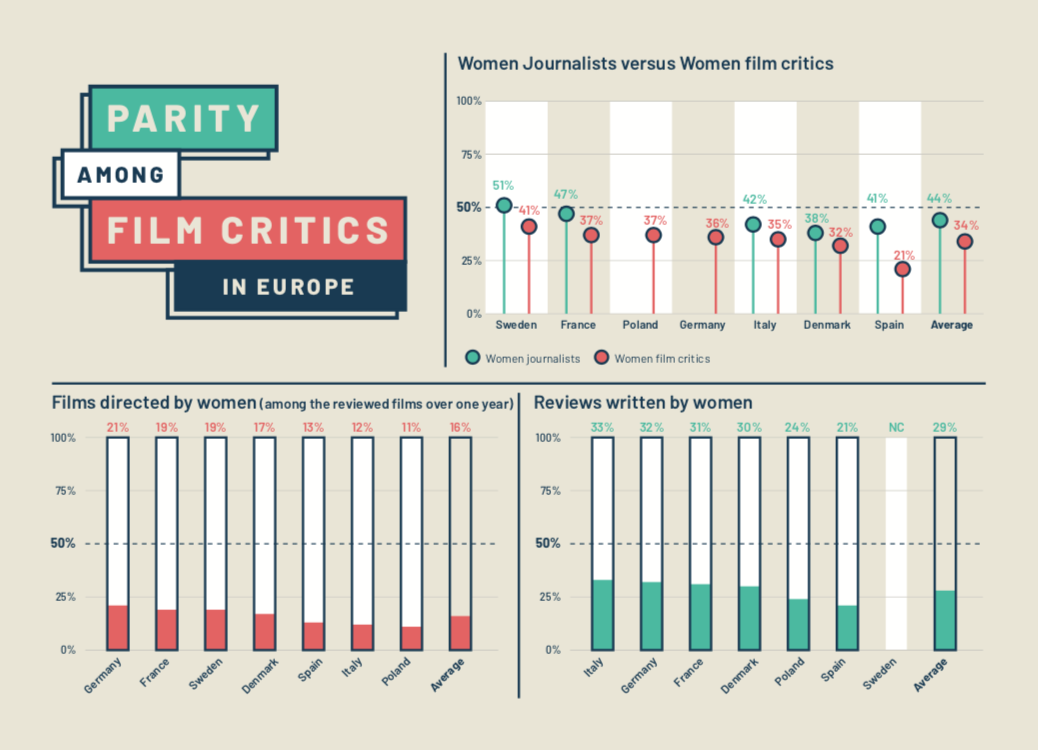Le Collectif 50/50 is expanding upon the research it conducted on gender representation among film critics. Last year the equality collective released a study revealing that women represent 47 percent of all registered journalists in France, yet only 37 percent of film critics. Now Collectif 50/50, in partnership with Creative Europe MEDIA, is broadening its scope to several other countries across Europe: Denmark, Germany, Italy, Poland, Spain, and Sweden. Findings from the “Parity Among Film Critics in Europe” report were presented yesterday at the Berlinale.
The study, which also includes the results from the “Parity Among Film Critics in France” publication, considered reviews written in the specified countries from September 2018 to October 2019 (except for the original French study, which uses the May 2018 to April 2019 timeframe). The authors found that women wrote an average of 28.5 percent of film reviews across Europe. “Despite slight differences, the numbers remain quite homogenous throughout our panel of countries,” they observed. Spain had the low of 21 percent and Italy the high of 33 percent. “Publications specializing in cinema or culture show an even lower rate of female-written reviews with an average of 24.3%,” according to the study’s press release.
Overall, women comprise an average of 34 percent of film critics across the countries studied, ranging from 21 percent (Spain) to 41 percent (Sweden). However, women represent an average of 44 percent of working journalists overall, marking quite a discrepancy between critics and journalists, which was also highlighted in the original French report.
Le Collectif 50/50 also analyzed the number of women-directed films reviewed during the selected time frames and — sadly, but not surprisingly — the numbers are nowhere near parity. On average, 16 percent of the films reviewed were helmed by women. Germany boasted the high of 21 percent, while the low went to Poland with 11 percent.
“Parity Among Film Critics in Europe” features the findings from interviews with working women film critics as well. Most believe that the disparity among critics affects a film’s audience reception. “The general feeling is that movies by and about white men get more coverage and that there is little interest to widen the perspective to lesser known filmmakers,” the authors revealed. “So the same movies get more coverage, and as a consequence more attention by the public and more viewers. Furthermore, what we regard as important and/or artistically relevant, is of course also defined by the people who have the power to create the notion of quality i.e. the film critics,” they added. “If they are all alike and tap in to the same notion of quality, it does form one common reception of the films.”
The majority of the female critics interviewed have faced gender discrimination in their profession, but “there is a general feeling of improvement in the representation of women in recent years. However [women] still struggle to access top positions, and the improvement of parity does not seem to mean more social or ethnical diversity,” according to the study. There is also consensus that film criticism is “becoming increasingly difficult to make a living out of,” film studies should be taught in school, and international networking opportunities for women critics should be implemented.
Male film reviewers outnumber females two to one in North America, per the Center for the Study of Women in Television and Film. Men comprise 66 percent of critics and penned 68 percent of reviews during the spring of 2019. In contrast women represent 34 percent of critics and wrote 32 percent of reviews.
The Berlinale runs through this Sunday, March 1. Its Competition section is composed of 18 titles, and six of them, or 33 percent, are directed or co-directed by women.
Go to Collectif 50/50’s website to read the “Parity Among Film Critics in Europe” report in full.








